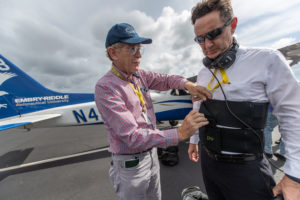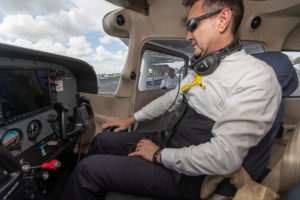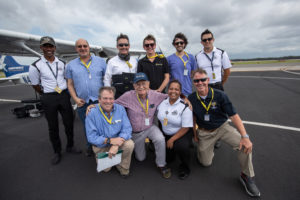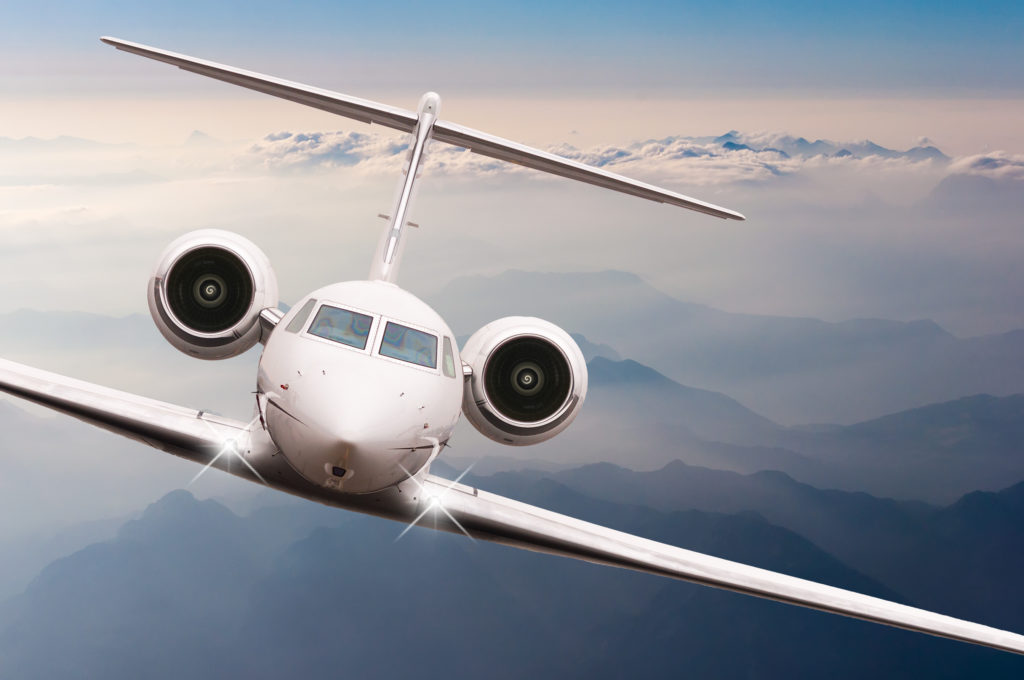Despite pilots learning about spatial disorientation during their training, it remains a leading factor in many accidents – engineers believe they have found a solution with a new suite of safety aids.
According to the Federal Aviation Authority between 5 to 10% of all general aviation accidents can be attributed to spatial disorientation, and 90% of these accidents are fatal.
Despite the FAA figures, attributing an accident to spatial disorientation is difficult given that pilots are usually unaware they are disoriented when it is happening and therefore unable to report on their condition, believes Doug Carr, the vice-president of regulatory and international affairs at the US National Business Aviation Association (NBAA). Even so, he says, “I believe it is not uncommon for accidents at the lighter end of the general aviation spectrum to have spatial disorientation as a contributing factor in some way.”
Understanding the biology

It is first important to understand the body’s systems that enable us to stay oriented to understand why a pilot gets disoriented, says Dr Braden McGrath, research professor at the Department of Human Factors and Behavioral Neurobiology at Florida’s Embry-Riddle Aeronautical University.
“We have three concordant redundant systems that keep us oriented in the world – our eyes, our inner ear and our skin-muscle joint system,” says McGrath. “They work really well together, but when you go flying two of the systems – the inner ear and the skin-muscle joint system – no longer work effectively.”
Without the help of these two systems, responsibility for staying spatially oriented falls to our eyes. For pilots this means scanning the horizon and their visual instruments for data on the plane’s orientation, says McGrath.
“The problem comes when we don’t have a view of the horizon or we get distracted from our instruments,” he says. “Then the brain can get information from the incorrect sources.”
These incorrect sources are the forces acting on the body during flight. When a plane accelerates or decelerates swiftly, enters a roll, pitch or yaw movement or some other maneuver, the inner ear – also known as the vestibular system – can confuse the resultant forces for the pull of gravity. Simply put, says McGrath, “the body misperceives down.”
Somewhat counter-intuitively spatial disorientation can often pose more of a danger when the forces are less severe says McGrath “When you’re pulling 3G you know you’re pulling 3G, so you’re going to be more alert. But a lot of spatial disorientation mishaps happen when the force is closer to 1G, because in those circumstances it’s much easier to assume that the force you’re feeling is normal gravitational pull.”
Instrument flying
The main counter measure to the problem of spatial disorientation is proficiency in instrument flying, says Carr.
A number of on-board instruments – such as the attitude indicator – provide vital data about the plane’s true orientation. Thorough instrument training teaches pilots not only proficiency in these instruments but also “to disregard signals their body is giving them about the orientation of the aircraft that are likely incorrect,” says Carr.

directly with the skin-muscle joint system, accessing a part of the cognitive system that responds reflexively
“Spatial disorientation is much more of an issue among new pilots,” says Carr. The business aviation industry is therefore providing information and outreach to pilots. “You’ll see it everywhere in the training curriculum,” he says. “It’s not something that the industry just sits by and waits for to happen.”
Even so, training doesn’t make a pilot immune to the risk. For example, Japan recently confirmed that the sudden crash of a Japanese F-35 stealth fighter in the Pacific Ocean in April 2019 was likely the result of spatial disorientation.
Despite having 3,200 hours of flight experience, accident investigators concluded that the jet’s pilot, Major Akinori Hosomi, lost his bearings, downing the flight in the sea during a night training mission. Why an experienced pilot like Hosomi would make such a mistake isn’t exactly clear.
But according to Dr Nick Gkikas, a flight deck and human factors engineer at Airbus Defence and Space, another important causal factor in spatial disorientation is the mental and physical strain that a pilot may be operating under because of their workload. “A lot of people might look at an incident like this and say, ‘How is it possible that this could happen to such an experienced pilot,’” says Gkikas.
“But they need to look at the data. If the pilot is having to cope with a combination of stress factors – high workload along with high physiological stress and high cognitive demands – then typically they are going to be more susceptible to this problem regardless of experience.”
Another reason why experience is no guarantee against spatial disorientation is that instrument flying is “a very fragile skill,” says McGrath, in the sense that “the brain always wants to go back to a natural way of interpreting our orientation.”
This means that if a pilot, either through fatigue or stress or some other factor, is distracted they may find themselves reverting unconsciously to this default state.
Another factor that might cause a pilot to become distracted and then disoriented is instructions from air traffic control (ATC), says Andy Watson, an air traffic controller and former air traffic safety inspector in Air Traffic Safety Oversight (ATSO) at the FAA Headquarters in Washington DC, USA.
“Essentially if you’re in a bank angle without reference to the horizon, so you’re in the cloud, if you move your head at all that’s where the problem comes up,” says Watson. “So, by air traffic control giving you a radio frequency change or a beacon change or a change en route where the pilot has to grab a pen and paper to write stuff down, if the pilot moves their head, they’re going to experience spatial disorientation.”
Watson saw exactly these types of scenarios when he attended the daily accident briefings of the Office of Accident Investigation and Prevention when he worked at the ATSO. His concern about the issue led him to submit an FAA safety recommendation to change ATC procedures for single-pilot aircraft – who Watson believes are the type of aircraft most at risk in these circumstances.
Watson’s recommendation was that following a turn a pilot must first report a wings level status before receiving any kind of instruction that might cause them to become disoriented. He also recommended adding training for air traffic controllers. He says his recommendation was denied on the grounds that taking measures to avoid spatial disorientation was the responsibility of pilots, not ATC crews.
Tactile Situation Awareness System

Embry-Riddle has investigated the use of the vibrating vest to warn pilots about spatial disorientation
McGrath’s research into spatial disorientated began in the 1990s when his study of the vestibular system led him to create a computer model that could predict when a pilot would experience spatial disorientation based on the flying conditions.
That research led him to Dr Angus Rupert, a research scientist at the US Army Aeromedical Research Laboratory. While McGrath’s model could diagnose the problem of spatial disorientation Rupert thought he had found a solution.
“The idea was very simple,” says McGrath. “He thought that since we have these three systems for balance and we lose two during flight, why not find a way to add one of them back.
“We couldn’t get into the vestibular system – it’s very deep within our skull – so the easiest one to add back was the skin-muscle joint system.”
To do this Rupert devised a belt worn around the pilot’s torso that gives cues about their true orientation. Known as the Tactile Situation Awareness System (TSAS) the belt has miniature tactile actuators sewn inside it that vibrate at different locations and intensities along a pilot’s torso.
The vibrations alert the pilot to irregularities in an aircraft’s orientation. For example, a plane roll to the right will trigger an actuator to go off in the pilot’s right side. In order to do this the belt pulls orientation data directly from aircraft’s distribution bus.
“The tactile cue on the body is pointing to the centre of the Earth even though the resultant force on your body could be pointing in any direction,” says Rupert. “It’s basically reminding the body where is down.”
The TSAS belt, which Rupert and McGrath are developing at Embry-Riddle’s Aerospace Physiology Lab, works so effectively that once it is operating “it’s not even possible to make pilots spatially disoriented, even if you try”, says McGrath.
This is because the belt interfaces directly with the skin-muscle joint system, accessing a part of our cognitive system that responds reflexively without the need for mental processing.
“Our tactile system is very basic and primeval,” he says. “It actually sits on top of the brain stem and is how you got around your mother’s womb – your vision and vestibular system came online much later in pregnancy.”
The concept of tactile cueing in aviation is not anything new, says McGrath. The stick shaker that warns pilots of an imminent stall is a form of tactile cueing, for example. Rupert’s main innovation has been to locate the cueing on the torso.
“It turns out the torso of our body is a very good 3D display,” says McGrath. Rupert and McGrath are hoping to eventually produce the TSAS belt commercially. In the private aviation sphere Rupert anticipates particular interest from emergency responders.
“That’s the community with the greatest need for something like this,” says Rupert. “They have a higher accident rate because they are more often landing at non-airport locations where the risk is greater.”





